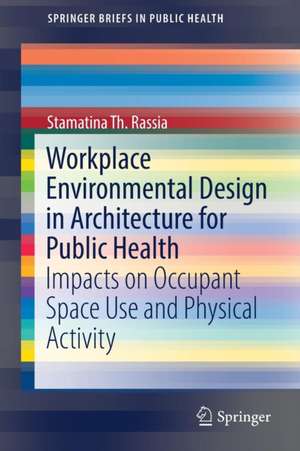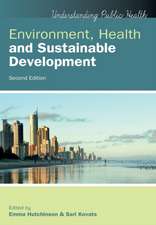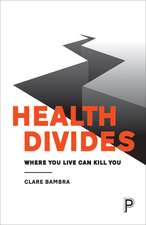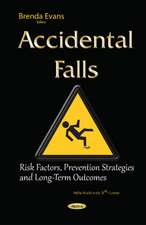Workplace Environmental Design in Architecture for Public Health: Impacts on Occupant Space Use and Physical Activity: SpringerBriefs in Public Health
Autor Stamatina Th. Rassiaen Limba Engleză Paperback – 11 apr 2017
This SpringerBrief is comprised of chapters on :
- Physical activity and disease: Theoryand practice
- Space-use and the history of the office building
- Identifying factors of the office architectural design that influence movement,
- Interdisciplinary research methods in studying worker physical activity, decision-making and office design characteristics
- The KINESIS model for simulating physical activity in office environments
Din seria SpringerBriefs in Public Health
- 5%
 Preț: 393.92 lei
Preț: 393.92 lei -
 Preț: 259.96 lei
Preț: 259.96 lei - 5%
 Preț: 337.70 lei
Preț: 337.70 lei - 5%
 Preț: 121.96 lei
Preț: 121.96 lei - 5%
 Preț: 164.59 lei
Preț: 164.59 lei - 5%
 Preț: 363.07 lei
Preț: 363.07 lei - 5%
 Preț: 356.32 lei
Preț: 356.32 lei - 5%
 Preț: 451.10 lei
Preț: 451.10 lei - 5%
 Preț: 360.34 lei
Preț: 360.34 lei - 5%
 Preț: 390.96 lei
Preț: 390.96 lei - 5%
 Preț: 388.02 lei
Preț: 388.02 lei - 5%
 Preț: 359.05 lei
Preț: 359.05 lei - 5%
 Preț: 359.05 lei
Preț: 359.05 lei - 5%
 Preț: 356.67 lei
Preț: 356.67 lei - 5%
 Preț: 388.02 lei
Preț: 388.02 lei - 5%
 Preț: 357.77 lei
Preț: 357.77 lei - 5%
 Preț: 419.76 lei
Preț: 419.76 lei - 5%
 Preț: 356.67 lei
Preț: 356.67 lei - 5%
 Preț: 420.68 lei
Preț: 420.68 lei - 5%
 Preț: 359.78 lei
Preț: 359.78 lei - 5%
 Preț: 389.88 lei
Preț: 389.88 lei -
 Preț: 481.58 lei
Preț: 481.58 lei - 5%
 Preț: 397.96 lei
Preț: 397.96 lei - 5%
 Preț: 423.95 lei
Preț: 423.95 lei - 5%
 Preț: 325.86 lei
Preț: 325.86 lei - 5%
 Preț: 452.39 lei
Preț: 452.39 lei - 5%
 Preț: 356.11 lei
Preț: 356.11 lei - 5%
 Preț: 357.41 lei
Preț: 357.41 lei - 5%
 Preț: 360.86 lei
Preț: 360.86 lei -
 Preț: 378.12 lei
Preț: 378.12 lei - 5%
 Preț: 391.16 lei
Preț: 391.16 lei - 5%
 Preț: 356.46 lei
Preț: 356.46 lei - 5%
 Preț: 387.29 lei
Preț: 387.29 lei - 5%
 Preț: 426.69 lei
Preț: 426.69 lei - 5%
 Preț: 360.51 lei
Preț: 360.51 lei - 5%
 Preț: 356.67 lei
Preț: 356.67 lei - 5%
 Preț: 360.34 lei
Preț: 360.34 lei - 5%
 Preț: 358.48 lei
Preț: 358.48 lei - 5%
 Preț: 485.32 lei
Preț: 485.32 lei -
 Preț: 377.35 lei
Preț: 377.35 lei - 5%
 Preț: 327.25 lei
Preț: 327.25 lei -
 Preț: 474.84 lei
Preț: 474.84 lei - 5%
 Preț: 425.04 lei
Preț: 425.04 lei - 5%
 Preț: 388.37 lei
Preț: 388.37 lei - 5%
 Preț: 361.06 lei
Preț: 361.06 lei - 5%
 Preț: 247.73 lei
Preț: 247.73 lei - 5%
 Preț: 355.38 lei
Preț: 355.38 lei -
 Preț: 379.09 lei
Preț: 379.09 lei -
 Preț: 443.58 lei
Preț: 443.58 lei - 5%
 Preț: 358.84 lei
Preț: 358.84 lei
Preț: 390.39 lei
Preț vechi: 410.94 lei
-5% Nou
Puncte Express: 586
Preț estimativ în valută:
74.70€ • 77.99$ • 61.82£
74.70€ • 77.99$ • 61.82£
Carte tipărită la comandă
Livrare economică 04-18 aprilie
Preluare comenzi: 021 569.72.76
Specificații
ISBN-13: 9783319534435
ISBN-10: 3319534432
Pagini: 89
Ilustrații: XVIII, 94 p. 15 illus.
Dimensiuni: 155 x 235 x 6 mm
Greutate: 0.17 kg
Ediția:1st ed. 2017
Editura: Springer International Publishing
Colecția Springer
Seria SpringerBriefs in Public Health
Locul publicării:Cham, Switzerland
ISBN-10: 3319534432
Pagini: 89
Ilustrații: XVIII, 94 p. 15 illus.
Dimensiuni: 155 x 235 x 6 mm
Greutate: 0.17 kg
Ediția:1st ed. 2017
Editura: Springer International Publishing
Colecția Springer
Seria SpringerBriefs in Public Health
Locul publicării:Cham, Switzerland
Cuprins
Part 1: Physical activity and disease: theory and practice sets out to demonstrate the relation between physical activity and the promotion of health. This includes presentation of the health-related approach associated with the increasingly sedentary lifestyles across the worldwide populations. It also describes how scientific research demonstrates the value of exploring the design for office site mobility.- Part 2: Space-use and the history of the office building represents an overview of the history of office architectural design from ancient to present times. Along with recent concepts, theories, and practice, it also introduces ideas on how the workplace is currently changing and how it further develops to respond to the current trends in office working.- Part 3: Research methods introduces the reader to current methods of measuring and mapping mobility in different environments and disciplines. Based on these, the methodsselected for the purposes of this research are presented.- Part 4: Identifying factors of the office architectural design that influence mobility illustrates research data collection results on the basis of which statistical analysis is carried out. From this analysis, a quantitative (KINESIS) model is designed.- Conclusion and further objectives are suggested in the final chapter of this book.
Notă biografică
Stamatina Th. Rassia is an architect engineer holding a diploma in Architecture Engineering from the National Technical University of Athens (NTUA) in Greece. She has an MPhil in Environmental Design in Architecture and a PhD in Architecture from the University of Cambridge in the United Kingdom. Dr. Rassia is an expert on topics of public health promotion by architectural design.
Textul de pe ultima copertă
This concise volume analyzes the potential for the workplace environment—where so many people spend so much of their day—to improve workers’ capacity for health and wellness. It pinpoints the link between sedentary lifestyles and poor health, and explores the role of office spatial design in encouraging physical activity to promote physical activity, health and prevent disease. The featured research study tracks workers’ movement in a variety of office layouts, addressing possible ways movement-friendly design can co-exist with wireless communication, paperless offices, and new corporate concepts of productivity. From these findings, the author’s conclusions extend public health concepts to recognize that influencing population-wide levels of activity through office architectural design alone may be possible.
This SpringerBrief is comprised of chapters on :
This SpringerBrief is comprised of chapters on :
- Physical activity and disease:Theory and practice
- Space-use and the history of the office building
- Identifying factors of the office architectural design that influence movement,
- Interdisciplinary research methods in studying worker physical activity, decision-making and office design characteristics
- The KINESIS model for simulating physical activity in office environments
Caracteristici
Enables readers to gain an overview of the challenges and opportunities that workplaces offer in increasing physical activity over the working day Offers a direct linkage between the layout of office spaces and the impacts on occupants' movement as well as their overall health and well-being Identifies the main approaches to designing to promote public health through design task alone Equips readers with new information based on experimental and empirical analyses (qualitative and quantitative) on the methods in which architecture interacts and influences occupants' activities, mobility, and space-use Reinforces the basic principles of designing for indoor office layouts as well as for promoting physical activity through real-life analysis, data collection, and modelling Enriches understanding of the power of design on its occupants' decisions and opportunities for health Updates readers involved in epidemiology and the research of public health promotion on new ways in which the architecture of spaces can influence behavioural changes as well as decision-making towards healthier and more physically active lifestyles Maximizes reader insights into the interdisciplinary topic of designing indoor workplace environments that can improve everyday lifestyles Includes supplementary material: sn.pub/extras















